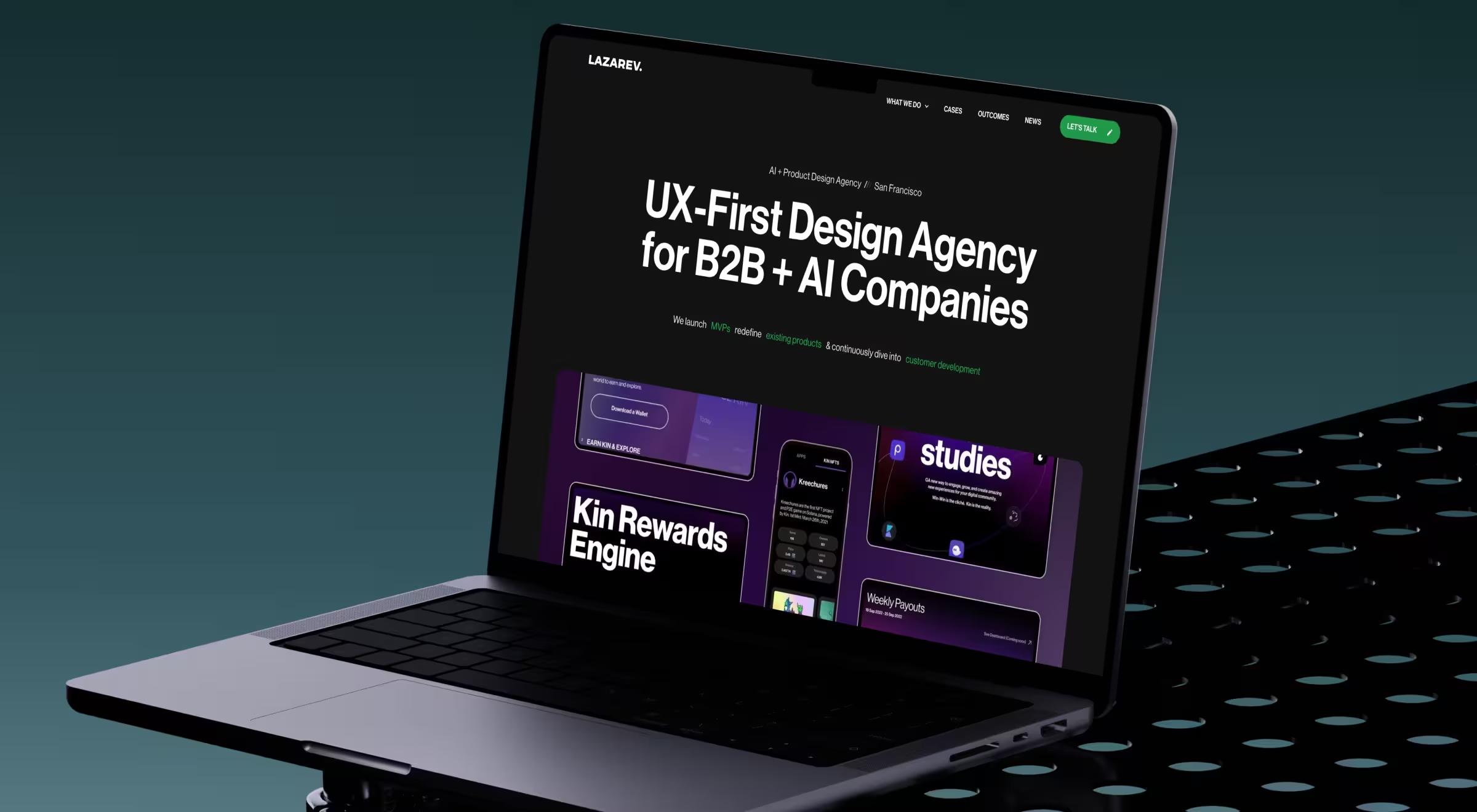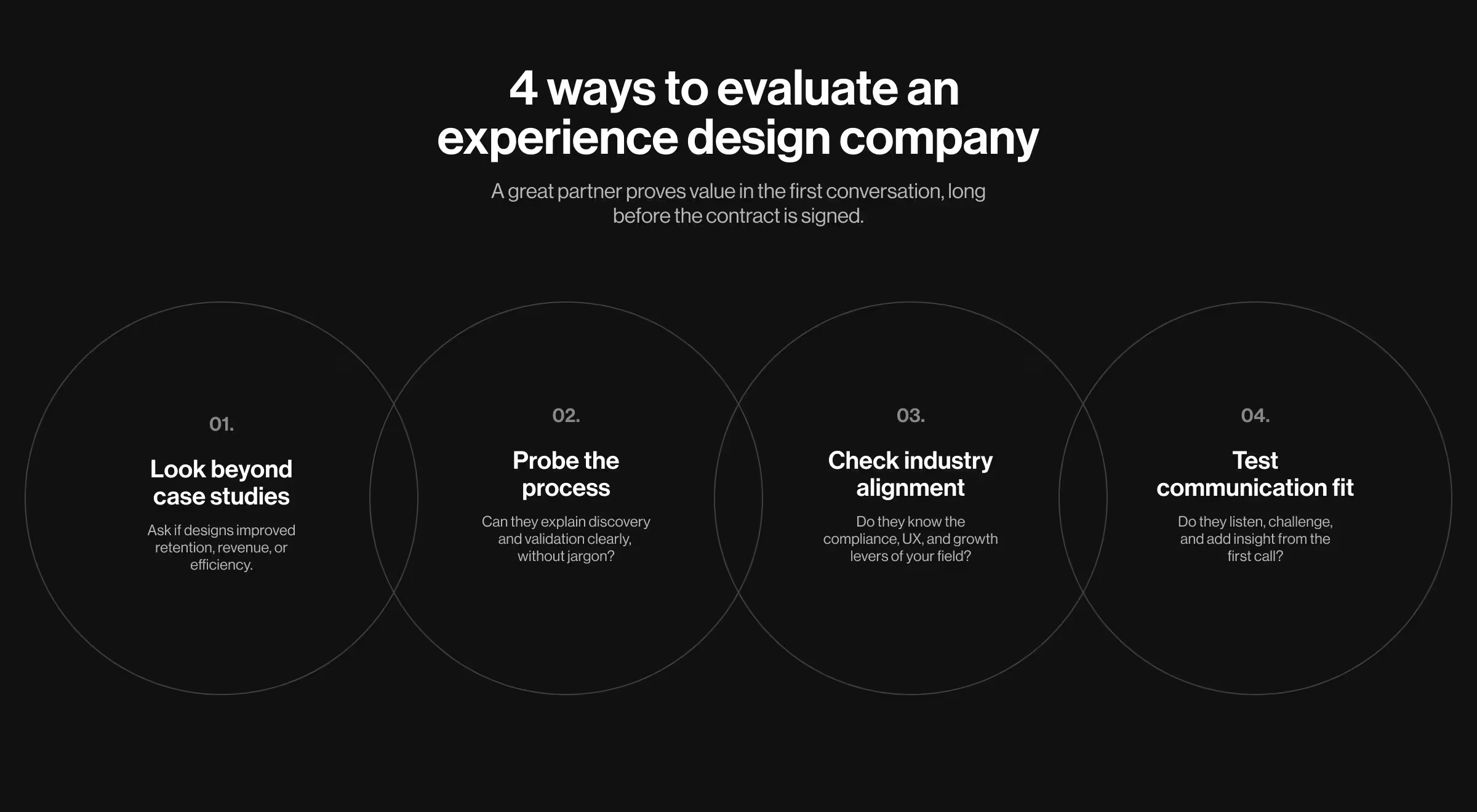Your team just launched a new product. The onboarding is smooth, the interface is intuitive, and the first-time user feels like the product was designed just for them. That’s the invisible hand of experience design companies shaping every interaction.
Yet, experience design doesn’t stop there. Here’s another part of the equation: users don’t judge your product against your competitors. They judge it against every great experience they’ve ever had — Amazon checkout, Airbnb booking, Spotify playlists, and much more. That means your product isn’t just in a category battle. It’s an experience battle you should be prepared to withstand.
This guide breaks down the top experience design agencies redefining how digital products onboard, engage, and retain. You’ll see who’s leading the pack, what frameworks they use, and how to pick the right partner for your journey.
Key takeaways
- Frameworks define outcomes. Leading agencies apply design thinking, JTBD, and agile UX to reduce waste and align teams.
- AI is a growth lever. Case studies show how AI turns complex workflows into guided, transparent, and interactive experiences.
- Choosing right matters. The strongest partner blends industry expertise, communication fit, and scalable systems.
9 best experience design agencies turning strategy into emotion
The right design partner is a team that can turn strategy into emotion, and emotion into loyalty.
Below, we’ve compared 9 experience design agencies recognized for delivering results that convert. Each company has its strengths, trusted processes, and unique trade-offs. The table provides a quick overview, while the detailed breakdown helps determine who best fits your product’s needs.
Lazarev.agency

A San Francisco–based leader known for setting AI UX rules since 2017. Lazarev.agency blends AI-driven product design, UX research, and bold creative direction. Their project portfolio spans AI, fintech, SaaS, and Web3. Clients collectively raised over $500M. Best for founders who want design as a growth lever.
🔍Explore our outcomes and portfolio.
Dotlogics
An established UX studio focusing on custom development and interaction design. Strong in healthcare, retail, and e-commerce, with deep CMS expertise. Great for businesses looking for integrated development and design solutions. Less focused on AI and more on robust builds.
🔍Explore the company’s portfolio.
Ignite Visibility
Blends digital marketing with UX and conversion design. Strong CRO expertise and analytics-driven processes. Perfect for brands that want design tied directly to growth metrics. Tilted more toward marketing than deep product design.
🔍Explore the company’s website.
500 Designs
Renowned for branding-first UX. Their team excels in motion design and storytelling. Ideal for startups and enterprises wanting a bold digital identity. Less tailored for highly complex B2B platforms.
🔍Explore the company’s portfolio.
CreativeWeb
Focused on affordable web and e-commerce builds (WordPress, Shopify, Magento). Great for SMEs and retail brands looking for execution speed. More tactical than strategic.
🔍Explore the company’s portfolio.
Bop Design
Specializes in B2B branding and UX. Strong in UX persona research and content-led UX for manufacturers and technology firms. Tailored for clarity and positioning. Less risk-taking in creativity.
🔍Explore the company’s portfolio.
Windmill Strategy
Strong in industries with complex products — industrial, tech, healthcare. Known for modular, scalable systems that grow with clients. A niche specialist rather than a generalist.
🔍Explore the company’s portfolio.
HUEMOR
Known for creative UX storytelling. Their projects are bold and visually immersive. Perfect for lifestyle and consumer brands that want differentiation. Riskier for conservative industries.
🔍Explore the company’s portfolio.
Excited
Startup-focused with lean processes and rapid prototyping. Agile and quick to test ideas, making it great for SaaS and early-stage companies. Less suited for large enterprise demands.
🔍Explore the company’s portfolio.
Experience design vs product design: when to hire which
Both experience design and product design aim to make technology feel effortless but they operate at different layers of the user journey. Think of them as two perspectives on the same map: one zoomed in on the path, the other zoomed out on the landscape.
What is product design?
Product design is the craft of shaping a single, tangible product — an app, dashboard, or digital tool — so it’s functional, intuitive, and visually clear. It’s where user research, interaction design, and interface aesthetics meet to remove friction from specific tasks.
Picture this: if your company were building a car, product design would focus on the steering wheel, dashboard, and seat ergonomics making every control feel natural in the driver’s hands.
Purpose: deliver usability, clarity, and delight within one focused environment.
Best suited for: startups validating an MVP or companies improving a core product experience.
What is experience design?
Experience design (XD) goes beyond interfaces. It’s about choreographing how users feel as they move through your entire ecosystem from the first ad click to customer support and beyond. It unites product, brand, and service design into one seamless narrative.
Imagine this: if your company is building that same car, experience design ensures the entire journey — from buying it online to the first drive and the post-sale service — feels consistent, human, and emotionally rewarding.
Purpose: connect every touchpoint into one coherent, emotionally resonant journey.
Best suited for: enterprises or scaling startups managing complex, multi-channel experiences.
Let’s check with real-life examples:
- When Spotify designs how music discovery, playlists, ads, and social sharing all blend into one continuous emotional arc — that’s experience design.
- When Figma refines how real-time collaboration feels — the cursor movement, comment sync, and interface speed — that’s product design.
Product design perfects the tool.
Experience design perfects the journey.
If your challenge spans onboarding, conversion, and retention — you’re past product design. You need experience design.
Industries that benefit most from experience design
Impact of experience design deepens when tailored to the nuances of each industry. Whether users are approving payments, managing health data, or onboarding into a SaaS tool, their expectations for clarity, speed, and emotion differ. Below is how experience design transforms outcomes across key sectors.
✅ Fintech example — Revolut & Cash App
Both turned dense financial data into intuitive experiences by blending microinteractions, trust indicators, and real-time feedback. Revolut’s animated transaction confirmations and Cash App’s minimal screens reduce anxiety around money movement — a hallmark of strong experience design.
✅ Healthcare example — MyChart & Philips HealthSuite
These platforms transformed patient portals into empathetic communication spaces, not just record-keeping tools. By surfacing only relevant information and humanizing data with color-coded cues, they increased engagement and trust in digital care.
✅ SaaS example — Notion & Slack
Each uses experience design to tame complexity. Notion’s modular blocks invite creativity while keeping order, and Slack’s conversational interface replaces hierarchy with flow proving that good design is invisible until it’s missing.
✅ E-commerce example — Nike & Sephora
Both brands blur the line between shopping and storytelling. Nike’s personalized dashboard suggests workouts and products based on user data, while Sephora’s guided routines bridge digital and physical experiences — both leveraging experience design to build emotional continuity across channels.
✅ Web3 example — Coinbase
Coinbase demystified crypto by turning abstract blockchain actions into recognizable UI patterns: progress bars, notifications, and transparent status updates. Their approach shows how UX clarity can make innovation approachable.
At Lazarev.agency, we apply the same principles across AI, fintech, SaaS, and Web3, designing systems that make intelligence feel intuitive.
- In AI, we’ve created interfaces that became industry benchmarks.
- In fintech, our focus on credibility signals and data transparency helps investors and analysts act faster.
- In SaaS, we reduce onboarding friction with adaptive dashboards and real-time guidance.
- And in Web3, we design educational, trust-first experiences that bridge complex technologies with human understanding.
The common thread: every industry’s challenge is different, but the goal of experience design stays the same — turning complexity into confidence and usability into delight.
Frameworks and tools experience design companies use, and why these matter
When you peel back the polished case studies of top experience design companies, you’ll see one thing in common: structured frameworks and toolchains.
Here’s what the best firms rely on and why it matters.
1. Design thinking
Everyone claims they use design thinking. Few actually do it rigorously. The real advantage lies in the empathy-driven discipline of walking through a user’s shoes and iterating until impactful solutions surface.
Agencies that apply it properly run fast discovery sprints and bake feedback in before any code is written.
👉 Why it matters: Design thinking reduces wasted development cycles, uncovers blind spots early, and aligns stakeholders around a shared vision.
2. Lean UX and agile integration
Experience design companies that thrive with scale-ups or SaaS products never treat design as a rigid waterfall process. They weave UX directly into agile sprints, testing and refining as they go.
👉 Why it matters: This prevents the dreaded “big reveal” where flaws surface too late, keeps teams shipping in small wins, and ensures the product evolves in step with the market.
3. Jobs to be done (JTBD)
This framework flips the perspective from “what features should we add?” to “what job is the user hiring our product to do?”. Agencies that get this right uncover hidden motivations.
For example, users don’t buy a project management tool for “task lists”. They buy it for peace of mind that nothing falls through the cracks.
👉 Why it matters: It shifts product roadmaps from chasing features to defining the experience.
4. Service blueprints and journey mapping
Top agencies visualize the entire ecosystem of user actions, touchpoints, backstage processes, and emotional highs/lows. These blueprints expose where customers drop off or become loyal advocates.
👉 Why it matters: This makes design a business strategy tool. Leaders suddenly see how operations, tech, and design interlock.
5. Modern tool stack
While tools evolve, the principles remain. The current toolkit of top agencies typically includes:
- Figma → industry standard for UI, prototyping, and collaboration.
- Miro or FigJam → workshops, customer journey mapping, real-time collaboration.
- Webflow → design-to-live builds for speed and fidelity.
- Hotjar or FullStory → behavioral analytics to validate assumptions.
- AI prototyping tools → accelerate ideation and test faster.
👉 Why it matters: Tools don’t replace frameworks, but they accelerate execution. The right stack lets agencies test hypotheses with users in days instead of months.
Experience design maturity framework
Every company designs experiences but not every company does it maturely. Experience design maturity reflects how deeply design thinking is embedded into your product and organization. The higher you climb, the more unified, adaptive, and intelligent your user experiences become.
Stage 1 — Interface-level UX: isolated screens
At this stage, design is primarily about making individual interfaces look and feel usable. Teams focus on aesthetics, layouts, and basic navigation. The product “works,” but each screen exists in isolation.
Symptoms: inconsistent components, disjointed handoffs between design and dev, limited user testing.
Example: Early mobile banking apps that looked modern but forced users to re-enter data between steps.
👉 Design is a surface layer, not yet a strategic function.
Stage 2 — Journey-based UX: mapped flows
Here, teams begin to connect the dots between screens, focusing on the user journey rather than isolated UI moments. Flows are mapped, personas are defined, and usability testing enters the process.
Symptoms: better handoffs, improved navigation, but user pain often reappears at system handovers (e.g., from marketing site to product dashboard).
Example: SaaS tools that improve onboarding but still lose users during feature adoption.
👉 You’ve moved from “pretty design” to “structured experience,” but still within silos.
Stage 3 — Integrated CX: unified across channels
At this maturity level, design thinking reaches beyond product screens. Teams align brand, marketing, product, and support around one customer experience. Consistency becomes a KPI, and systems thinking guides design decisions.
Symptoms: integrated feedback loops, shared design systems, seamless omnichannel handovers.
Example: Apple or Airbnb — where marketing, onboarding, and support all feel like one continuous dialogue with the brand.
👉 Design is now an organizational strategy, not just a product discipline.
Stage 4 — Intelligent experience design: adaptive and predictive
This is where top experience design companies operate. AI, data, and design work together to anticipate needs before users act. Experiences become adaptive, personalized, and emotionally tuned.
Symptoms: real-time adaptation, predictive suggestions, and measurable growth impact.
Example: Netflix’s AI-driven recommendations, Amazon’s anticipatory logistics, or Spotify’s “Made for You” playlists — all powered by intelligent experience design.
👉 Design evolves into an intelligent ecosystem that learns, adapts, and scales.
Quick diagnostic: where do you stand?
- If your design process ends at UI testing, you’re at Stage 2.
- If your customer journey feels consistent across marketing and product, you’re in Stage 3.
- If your product adapts to user context or behavior, you’re entering Stage 4.
To compete with Amazon-level experiences, you can’t stop at design systems — you need adaptive ones. That’s exactly where Lazarev.agency’s UX designers step in, turning static interfaces into living systems that learn and evolve with your users.
How to choose the right experience design company

Most experience design agencies look good on paper. But the difference between a successful partnership and an expensive disappointment comes down to how you evaluate them.
1. Look past the case studies
Consider the agency’s portfolio critically. Ask:
- What outcome did this design achieve?
- Did conversions climb?
- Did churn drop?
- Did onboarding time shrink?
The best agencies tie aesthetics back to business impact.
👉 Insider tip: If a case study only talks about “modern” design, and not retention, revenue, or efficiency, that’s a red flag.
2. Evaluate the design process
Ask agencies to walk you through how they gather requirements, run discovery, prioritize features, and validate design decisions. If their process feels vague, they may not be ready for complex product challenges.
👉 Good agencies can explain their methodology in plain English. Bad ones hide behind jargon.
3. Check industry alignment
Every industry has its quirks. Fintech needs trust cues and compliance. Healthcare demands accessibility. B2B SaaS thrives on clarity and onboarding efficiency. The right partner must know your space.
👉 Shortcut: Review their past work and see if they’ve solved problems in the industries similar to yours.
4. Test communication fit
Experience design thrives on ongoing communication. You’ll be in workshops, sprints, and feedback loops. The agency’s communication style can make or break the project.
👉 Watch how they handle your first calls. Are they listening more than selling? Do they challenge assumptions with insight? Or are they nodding along to win the deal?
AI in experience design: how best web design partners turn clicks into instincts
AI is no longer a backend feature. In the hands of top experience design companies, it makes every click feel intuitive and emotionally tuned. Here’s how AI helps achieve transformative digital experiences when paired with the right design expertise.
Guided decisions
AI tools help surface exactly what users need when they need it. Instead of navigating generic dashboards, users get context-aware guidance that trims decisions and accelerates workflows.
✅Case in point: With Accern.Rhea, Lazarev.agency designed a hybrid GUI + AI prompt interface where analysts see only the widgets and datasets relevant to their query. By filtering noise into clarity, we turned research into an instinctive flow.
Trust through transparency
AI builds confidence when users can see how it works. By exposing reasoning, highlighting bias, or surfacing blind spots, AI shifts perception from “black box” to trusted advisor.
✅Case in point: With VTnews.ai, Lazarev.agency designed a system where AI not only aggregates stories but also displays bias scales, coverage disparities, and multi-perspective summaries. Readers instantly understand the balance of viewpoints, making trust a built-in feature of the experience.
Effortless interactions at high-intent moments
The moments that shape your product experience are the critical first clicks: signing up, searching, checking out. This is where users decide if your product feels natural or like work. AI steps in here to smooth the path.
✅Case in point: For Pika AI, we placed an AI-powered chat assistant directly under the search bar. Users simply type, click, or chat and the system adapts instantly. This way, we achieved less friction, faster answers, and a product that feels intuitive from the very first use.
Emotion through storytelling
AI delivers the logic. And design translates it into emotion. When paired with strong narratives, AI-enabled products can feel less like tools and more like memorable experiences.
✅Case in point: For Mannequin, we turned AI’s ability to generate diverse fashion models into a story-driven, parallax-rich platform. By focusing on narrative and visual flow, we showcased the tech as approachable and human-centered, giving users confidence in a product innovation they might otherwise distrust.
Don’t just compete, win the experience design battle
You’re not competing with the company next door. You’re competing with every experience your users already know. That’s why choosing the right experience design company is a strategic decision.
At Lazarev.agency, we’ve set AI UX rules since 2017. Our work with clients like Accern, VTnews.ai, Pika AI, and Mannequin shows how design can raise over $500M in funding and transform startups into category leaders.
If you’re ready to design immersive experiences that users remember, get in touch to discuss your project.




























.webp)




















